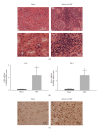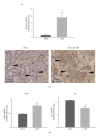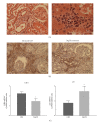Overexpression of Delayed Rectifier K(+) Channels Promotes In situ Proliferation of Leukocytes in Rat Kidneys with Advanced Chronic Renal Failure
- PMID: 22701172
- PMCID: PMC3369525
- DOI: 10.1155/2012/581581
Overexpression of Delayed Rectifier K(+) Channels Promotes In situ Proliferation of Leukocytes in Rat Kidneys with Advanced Chronic Renal Failure
Abstract
Leukocytes, such as lymphocytes and macrophages, predominantly express delayed rectifier K(+) channels (Kv1.3), and the channels play crucial roles in the activation and proliferation of the cells. Since lymphocytes are activated in patients with end-stage renal disease (ESRD), the channels expressed in those cells would contribute to the progression of renal fibrosis in advanced-stage chronic renal failure (CRF). In the present study, using a rat model with advanced CRF that underwent 5/6 nephrectomy followed by a 14-week recovery period, we examined the histopathological features of the kidneys and the leukocyte expression of Kv1.3-channels and cell cycle markers. Age-matched sham-operated rats were used as controls. In the cortical interstitium of advanced CRF rat kidneys, leukocytes proliferated in situ and overexpressed Kv1.3 channel protein in their cytoplasm. Treatment with margatoxin, a selective Kv1.3-channel inhibitor, significantly suppressed the number of leukocytes and the progression of renal fibrosis with a significant decrease in the cortical cell cycle marker expression. This study demonstrated for the first time that the number of leukocytes was dramatically increased in rat kidneys with advanced CRF. The overexpression of Kv1.3 channels in the leukocytes was thought to contribute to the progression of renal fibrosis by stimulating cell cycling and promoting cellular proliferation.
Figures



Similar articles
-
Roles of lymphocyte kv1.3-channels in the pathogenesis of renal diseases and novel therapeutic implications of targeting the channels.Mediators Inflamm. 2015;2015:436572. doi: 10.1155/2015/436572. Epub 2015 Mar 18. Mediators Inflamm. 2015. PMID: 25866450 Free PMC article. Review.
-
Benidipine suppresses in situ proliferation of leukocytes and slows the progression of renal fibrosis in rat kidneys with advanced chronic renal failure.Nephron Exp Nephrol. 2014;128(1-2):67-79. doi: 10.1159/000368080. Epub 2014 Oct 24. Nephron Exp Nephrol. 2014. PMID: 25358915
-
Delayed Rectifier K+-Channel Is a Novel Therapeutic Target for Interstitial Renal Fibrosis in Rats with Unilateral Ureteral Obstruction.Biomed Res Int. 2019 Nov 7;2019:7567638. doi: 10.1155/2019/7567638. eCollection 2019. Biomed Res Int. 2019. PMID: 31828127 Free PMC article.
-
Less contribution of mast cells to the progression of renal fibrosis in Rat kidneys with chronic renal failure.Nephrology (Carlton). 2017 Feb;22(2):159-167. doi: 10.1111/nep.12733. Nephrology (Carlton). 2017. PMID: 26840502
-
Physiological significance of delayed rectifier K(+) channels (Kv1.3) expressed in T lymphocytes and their pathological significance in chronic kidney disease.J Physiol Sci. 2015 Jan;65(1):25-35. doi: 10.1007/s12576-014-0331-x. Epub 2014 Aug 6. J Physiol Sci. 2015. PMID: 25096892 Free PMC article. Review.
Cited by
-
Roles of lymphocyte kv1.3-channels in the pathogenesis of renal diseases and novel therapeutic implications of targeting the channels.Mediators Inflamm. 2015;2015:436572. doi: 10.1155/2015/436572. Epub 2015 Mar 18. Mediators Inflamm. 2015. PMID: 25866450 Free PMC article. Review.
-
Pathological and functional significance of aging mouse kidneys: clinical implications to reduce the risk of hyper- or hypokalemia in the elderly.Kidney Res Clin Pract. 2024 Nov;43(6):703-708. doi: 10.23876/j.krcp.24.012. Epub 2024 Aug 7. Kidney Res Clin Pract. 2024. PMID: 39109398 Free PMC article.
-
Margatoxin mitigates CCl4‑induced hepatic fibrosis in mice via macrophage polarization, cytokine secretion and STAT signaling.Int J Mol Med. 2020 Jan;45(1):103-114. doi: 10.3892/ijmm.2019.4395. Epub 2019 Nov 4. Int J Mol Med. 2020. PMID: 31746414 Free PMC article.
-
Targeting ACE2 as a potential prophylactic strategy against COVID-19-induced exacerbation of chronic kidney disease.Inflamm Res. 2022 Nov;71(10-11):1123-1126. doi: 10.1007/s00011-022-01619-6. Epub 2022 Jul 24. Inflamm Res. 2022. PMID: 35871404 Free PMC article.
-
Therapeutic potential of voltage-dependent potassium channel subtype 1.3 blockade in alleviating macrophage-related renal inflammation and fibrogenesis.Cell Death Discov. 2025 May 5;11(1):218. doi: 10.1038/s41420-025-02508-7. Cell Death Discov. 2025. PMID: 40324999 Free PMC article.
References
-
- Shah BV, Levey AS. Spontaneous changes in the rate of decline in reciprocal serum creatinine: errors in predicting the progression of renal disease from extrapolation of the slope. Journal of the American Society of Nephrology . 1992;2(7):1186–1191. . - PubMed
-
- Klahr S, Levey AS, Beck GJ, et al. The effects of dietary protein restriction and blood-pressure control on the progression of chronic renal disease. The New England Journal of Medicine . 1994;330(13):877–884. . - PubMed
-
- Locatelli F, Marcelli D, Comelli M, et al. Proteinuria and blood pressure as causal components of progression to end-stage renal failure. Nephrology Dialysis Transplantation . 1996;11(3):461–467. . - PubMed
-
- El Nahas AMAS, Harris KPG, editors. Mechanisms and Management of Progressive Renal Failure . London, UK: Oxford University Press; 2000. .
-
- Perneger TV, Klag MJ, Whelton PK. Recreational drug use: a neglected risk factor for end-stage renal disease. American Journal of Kidney Diseases . 2001;38(1):49–56. . - PubMed
LinkOut - more resources
Full Text Sources
Other Literature Sources

